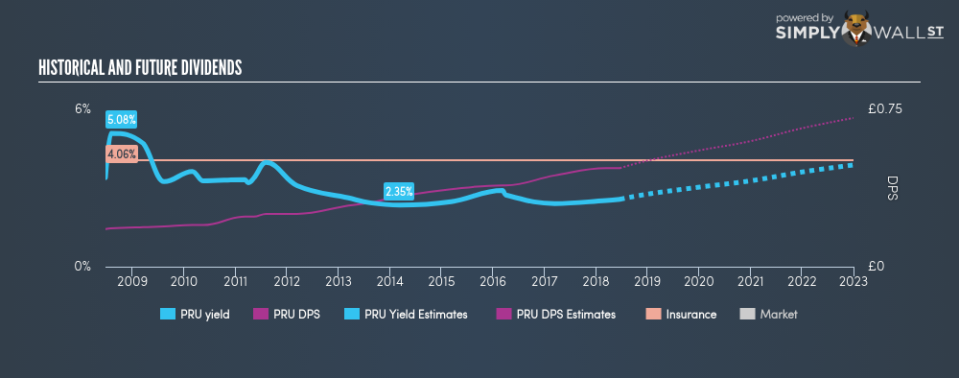What Makes Prudential plc (LON:PRU) A Great Dividend Stock?

There is a lot to be liked about Prudential plc (LON:PRU) as an income stock, over the past 10 years it has returned an average of 3.00% per year. The company currently pays out a dividend yield of 2.57% to shareholders, making it a relatively attractive dividend stock. Let’s dig deeper into whether Prudential should have a place in your portfolio. See our latest analysis for Prudential
5 checks you should do on a dividend stock
Whenever I am looking at a potential dividend stock investment, I always check these five metrics:
Is it paying an annual yield above 75% of dividend payers?
Has it consistently paid a stable dividend without missing a payment or drastically cutting payout?
Has dividend per share amount increased over the past?
Can it afford to pay the current rate of dividends from its earnings?
Based on future earnings growth, will it be able to continue to payout dividend at the current rate?
How well does Prudential fit our criteria?
The current trailing twelve-month payout ratio for the stock is 50.50%, meaning the dividend is sufficiently covered by earnings. However, going forward, analysts expect PRU’s payout to fall to 32.42% of its earnings, which leads to a dividend yield of 3.09%. However, EPS should increase to £1.49, meaning that the lower payout ratio does not necessarily implicate a lower dividend payment.
Reliablity is an important factor for dividend stocks, particularly for income investors who want a strong track record of payment and a positive outlook for future payout. In the case of PRU it has increased its DPS from £0.18 to £0.47 in the past 10 years. It has also been paying out dividend consistently during this time, as you’d expect for a company increasing its dividend levels. This is an impressive feat, which makes PRU a true dividend rockstar.
Compared to its peers, Prudential produces a yield of 2.57%, which is on the low-side for Insurance stocks.
Next Steps:
With these dividend metrics in mind, I definitely rank Prudential as a strong income stock, and is worth further research for anyone who considers dividends an important part of their portfolio strategy. Given that this is purely a dividend analysis, you should always research extensively before deciding whether or not a stock is an appropriate investment for you. I always recommend analysing the company’s fundamentals and underlying business before making an investment decision. I’ve put together three essential aspects you should further research:
Future Outlook: What are well-informed industry analysts predicting for PRU’s future growth? Take a look at our free research report of analyst consensus for PRU’s outlook.
Valuation: What is PRU worth today? Even if the stock is a cash cow, it’s not worth an infinite price. The intrinsic value infographic in our free research report helps visualize whether PRU is currently mispriced by the market.
Other Dividend Rockstars: Are there better dividend payers with stronger fundamentals out there? Check out our free list of these great stocks here.
To help readers see pass the short term volatility of the financial market, we aim to bring you a long-term focused research analysis purely driven by fundamental data. Note that our analysis does not factor in the latest price sensitive company announcements.
The author is an independent contributor and at the time of publication had no position in the stocks mentioned.

 Yahoo Finance
Yahoo Finance 
